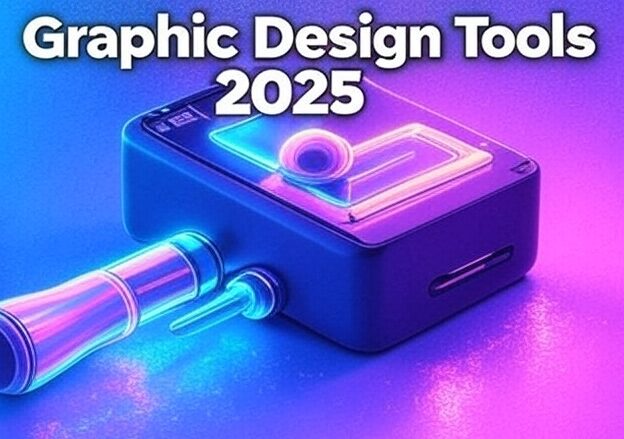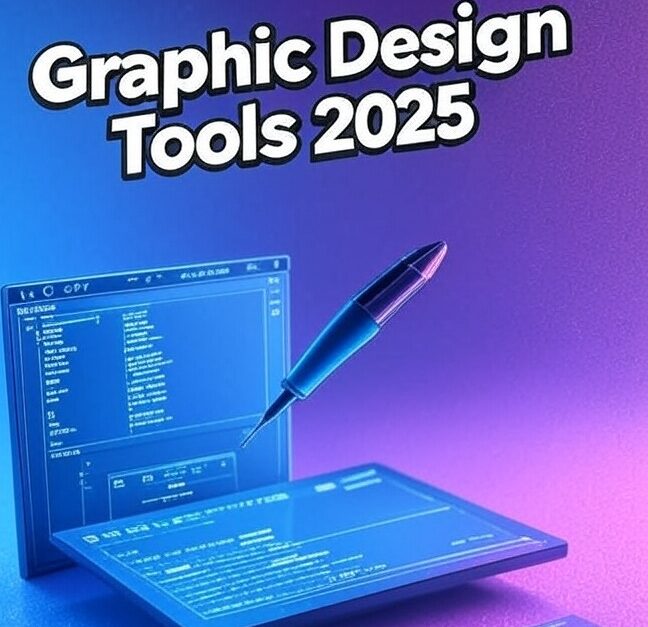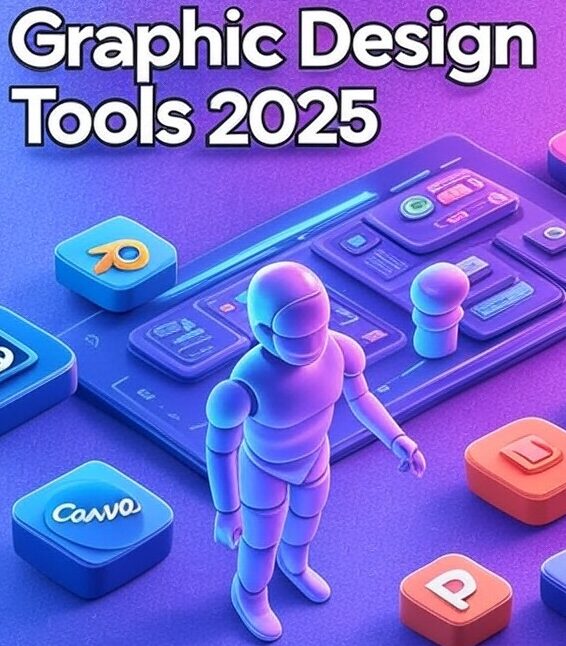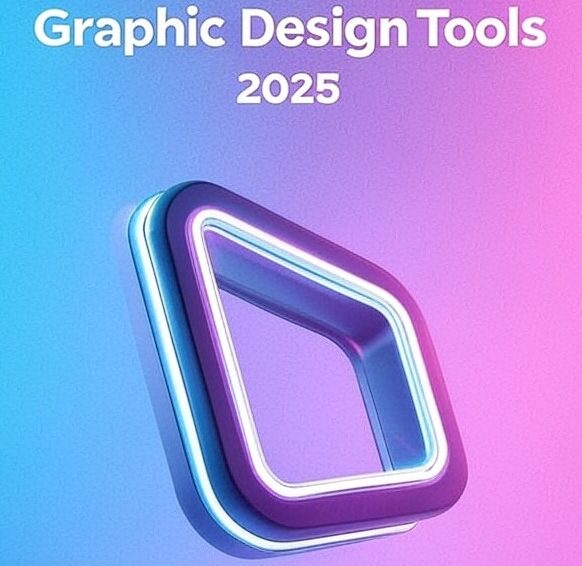
The graphic design world is transforming rapidly, with graphic design tools 2025 leading the charge in innovation. Tools like Figma and trends such as 3D elements and textured effects are redefining creative possibilities, making it essential for designers to stay ahead. Embracing these advancements ensures competitive, engaging designs that captivate audiences. This post, tied to Section 3 of our pillar post, “Mastering Graphic Design Projects 2025: Your Ultimate Creative Blueprint” dives into the latest graphic design tools 2025 and trends. Get ready for an exciting review to elevate your design game!

Review of Top Graphic Design Tools for 2025
Figma: The Collaborative Powerhouse
Figma continues to dominate as the leading cloud-based design tool in 2025, renowned for its real-time collaboration and versatility in UI/UX design. Its browser-based platform allows teams worldwide to edit designs simultaneously, streamlining workflows for designers, developers, and stakeholders. At Config 2025, Figma unveiled transformative updates, including enhanced 3D plugins like Spline and Vectary, which integrate seamless 3D modeling directly into the canvas. Figma Make, an AI-driven prompt-to-code tool, enables designers to transform designs into functional prototypes with simple text prompts, powered by Anthropic’s Claude 3.7 model. Improved prototyping features, such as advanced interactions and responsive layouts via the new Grid system, make Figma a one-stop solution for creating dynamic, high-fidelity designs. These updates align with 2025’s demand for immersive, interactive experiences, positioning Figma as the go-to for graphic design tools 2025.
Complementary Tools for a Versatile Workflow
Figma excels in collaboration and prototyping, complementary tools enhance its capabilities. Adobe Photoshop remains unmatched for textured effects, offering AI-powered tools like content-aware fill and layer-based editing to create grainy, tactile visuals that counterbalance AI-generated perfection. Designers can import Photoshop assets into Figma for refined UI designs. Blender, an open-source 3D modeling software, is ideal for crafting detailed 3D renders and animations. Its robust sculpting and rendering tools pair with Figma’s 3D plugins to integrate complex models into prototypes. Canva, with its user-friendly, template-based approach, caters to quick social media graphics and marketing materials. Its drag-and-drop interface complements Figma’s precision for rapid content creation.
Alignment with 2025 Trends
These tools align with 2025’s graphic design trends, particularly 3D rendering and textured effects. Figma’s 3D plugins like Spline enable designers to embed interactive 3D elements, while Photoshop’s texture tools and Blender’s rendering capabilities support the tactile, authentic aesthetic trending in branding and UI. By combining Figma’s collaborative ecosystem with Photoshop’s editing prowess, Blender’s 3D modeling, and Canva’s speed, designers can create versatile, trend-forward workflows that meet 2025’s demands for immersive, engaging visuals.

Key Graphic Design Trends for 2025
3D Elements: Elevating Visual Depth
In 2025, 3D elements are revolutionizing UI/UX, branding, and web design, driven by their ability to create immersive, engaging experiences. From dimensional typography to hyperrealistic product renders, 3D designs add depth and interactivity that captivate users. Tools like Spline and Vectary, integrated as Figma plugins, make 3D accessible by allowing designers to craft and animate 3D models directly within Figma’s collaborative environment. For instance, Spline enables smooth 3D object manipulation, while Vectary supports complex renders for web and app interfaces. Real-world examples include Spotify’s 3D icons, which add playful depth to its UI, and e-commerce sites using hyperrealistic product visualizations to boost conversions. These tools democratize 3D design, enabling even beginners to create dynamic, trend-forward visuals that align with 2025’s demand for immersive storytelling.
Textured Effects: Authenticity in a Digital Age
Textured effects are surging in 2025 as designers counter the polished perfection of AI-generated visuals with grainy, tactile aesthetics. Noise grain, risograph-inspired patterns, and analog-style textures bring depth and authenticity to designs, evoking nostalgia and human connection. For example, Blazing Beauty’s 2025 branding uses grainy textures to convey warmth and individuality, distinguishing it in a crowded market. In Figma, plugins like Noise and Vector to 3D simplify texture creation, allowing designers to overlay grain or distressed effects on UI elements or illustrations. These effects are versatile, enhancing everything from social media graphics to packaging, and resonate with audiences seeking genuine, tactile experiences in a digital world.
Why These Trends Matter
3D elements and textured effects are more than aesthetic choices—they drive user engagement and brand storytelling. 3D designs create interactive, memorable interfaces that hold attention, as seen in Spotify’s dynamic icons or Tangier Jazz Festival’s textured banners, which blend grainy visuals with bold typography for cultural resonance. Textures add emotional depth, making brands feel approachable and authentic, while 3D elements elevate functionality, like interactive product demos that boost e-commerce sales. By leveraging graphic design tools 2025 like Figma’s plugins, designers can harness these trends to craft compelling narratives that stand out in a competitive landscape, ensuring brands connect deeply with their audiences.

How to Leverage These Tools and Trends
How to Leverage These Tools and Trends
To stay ahead in 2025, designers can harness graphic design tools 2025 like Figma and trends like 3D elements and textured effects to create standout visuals. Start with Figma’s 3D plugins, such as Spline or Vectary, to experiment with interactive 3D elements. Try adding dimensional typography to a landing page or a 3D product render to an e-commerce prototype for immersive user experiences. For textured effects, use Figma plugins like Noise to apply subtle grain or analog-inspired overlays, enhancing authenticity in branding or UI designs. Pair these with Adobe Photoshop for intricate texture edits, then import assets into Figma for seamless integration.
Begin small: test free Figma plugins like Vector to 3D to create tactile buttons or textured backgrounds without complex software. Combine 3D and textures for maximum impact, like a 3D logo with a grainy finish for a modern yet nostalgic vibe. These techniques elevate engagement, as seen in Spotify’s dynamic icons. For deeper strategies, explore Section 3 of our pillar post, “Mastering Modern Design Workflows,” to optimize your process. Experiment, iterate, and watch your designs captivate audiences in 2025’s competitive landscape.
Conclusion: Stay Ahead in 2025
Mastering graphic design tools 2025 like Figma and embracing trends such as 3D elements and textured effects is crucial for creating impactful, authentic designs. These tools and trends enable designers to craft engaging visuals that resonate with audiences and elevate brand storytelling. Experiment with Figma’s 3D plugins or textured overlays to push your creative boundaries and stay competitive. Check out Section 3 of our pillar post, “Mastering Modern Design Workflows,” for more on optimizing your design workflow! Share your favorite tools or trends in the comments and inspire the design community!
